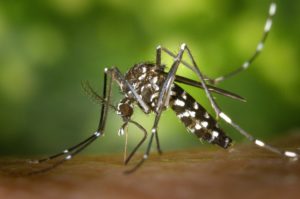What do you think is the deadliest animal in the world? Is it the lion, the so-called king of animals? Is it the hippo, with its aggressive and territorial nature on anything that crosses its path? Or maybe it’s something like an elephant, that tramples all in its way?
It’s actually none of these. While these animals can indeed lead to a painful and gruesome death for humans that encounter them on the wrong day, they’re nothing compared to one tiny little annoying fluttering bug.
Yes, that’s right. If you’ve seen the title of this article, then you know that I’m talking about the mosquito.
But how can such a tiny little insect cause so much death? The answer, my friend, is disease. In fact, over one million people die from disease caught from a mosquito bite per year. This is because like ticks, mosquitoes are the perfect vectors for disease to spread, so be warned. That one little bite might seem annoying at first, until you start getting sick later on.
But what kind of diseases can a mosquito spread? That’s what this article is here to talk about.
Malaria
One of the best-known tropical disease out there, Malaria comes from a parasite called Plasmodium, which is a unicellular organism. Over one million people die from malaria, while an estimated 300-600 million people suffer from it every year. Most of these cases come from countries that do not receive ample assistance in dealing with matters of health, like Sub-Saharan Africa.
One will only start feeling the effects of Malaria after a week or two of being bitten by an Anopheles mosquito, of which the symptoms include fever, vomiting, fatigue, and headaches. However, over the course of the disease, extreme damage to the nervous system can occur.
Which mosquito can spread it?
As of now, the only mosquito that can actually spread Malaria is the Anopheles mosquito, and they must have been infected from a previous person that they took a blood meal from.
Dengue
Dengue is also a common disease transmitted by mosquitoes. Unlike Malaria, however, Dengue is caused by a virus instead of a parasite.
Symptoms of dengue vary, but they usually occur in around 4-13 days after being bitten by a mosquito infected with dengue. Such symptoms include fever, headaches, as well as joint and muscle pains. To make matters worse, dengue has 4 different strains that make reinfection a possibility, meaning that even if you get infected once, you can still get infected three more times. If you get infected a second or third time, your body may go into overdrive with its antibodies, and potentially end up killing you from the inside.
Which mosquito can spread it?
The Tiger mosquito is a well-known vector for dengue transmission. Dengue is quite widespread all over the world, from Thailand, to South America, to sub-Saharan Africa, and even some southern states of the United States.
Yellow Fever
Yellow fever, while not having as many cases as Dengue or Malaria, is still a significant risk to people who are afflicted by it. Around 84,000 to 170,000 people are infected by Yellow Fever each year, and up to 60,000 deaths per year are attributed to this disease.
Symptoms of Yellow Fever include: High fever, nausea, and headache. Symptoms generally appear in a week or less.
Which mosquito can spread it?
Yellow Fever is transmitted via the Yellow Fever mosquito, but recent research has shown that they are now being transmitted through the Tiger mosquito as well. Countries in danger of being infected by Yellow Fever are ones located in Africa as well as South and Central America.
Zika Virus
The Zika virus is a relatively new disease that can be transmitted by mosquitoes, and there have been few cases in history barring an outbreak in Brazil in 2015.
Most people who contract the Zika virus, around eighty percent of people, do not experience symptoms associated with it, but the remaining twenty percent who do experience things like fever, rashes, conjunctivitis, and joint pain. Most of these are minor issues that will go away with time for adults.
What makes the Zika virus worrying, however, is its effects on babies born from mothers that had the disease while pregnant. The disease has the worrying effect of causing these babies to be born with disabilities, in which the skull reduction, microcephaly, is of particular note.
Which mosquito can spread it?
The yellow fever mosquito and the tiger mosquito are both known disease vectors for the Zika virus. They are primarily transmitted in tropical regions, such as the Philippines, Thailand, and Vietnam. This also includes tropical regions of Africa, as well as South and Central America.
West Nile Virus
The West Nile virus is notable for being a danger to the elderly or those with a weakened immune system. Symptoms include shaking, chills, fever, headache, muscle pain, nausea, fatigue, vomiting, as well as dizziness. Eighty percent of infections do not result in such symptoms, and as such, are usually unnoticed.
In extreme cases, the disease can impact the central nervous system and cause meningitis or myocarditis.
Which mosquito can spread it?
The Culex mosquito is the primary spreader of these viruses. While they are native to Asian and African countries, they have since spread all across the world, and have been found in many parts of Canada, Europe, and the US.

